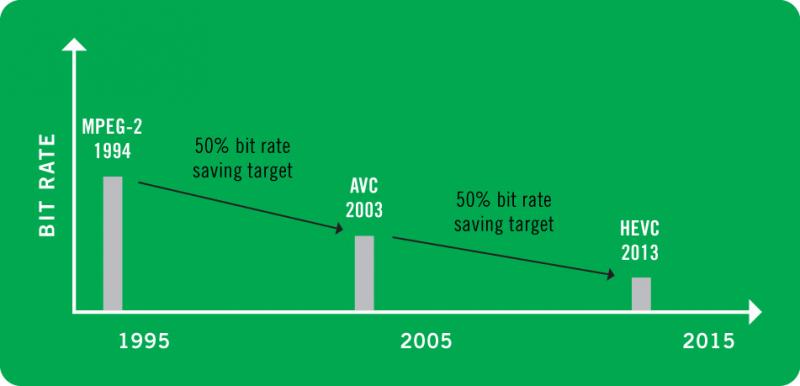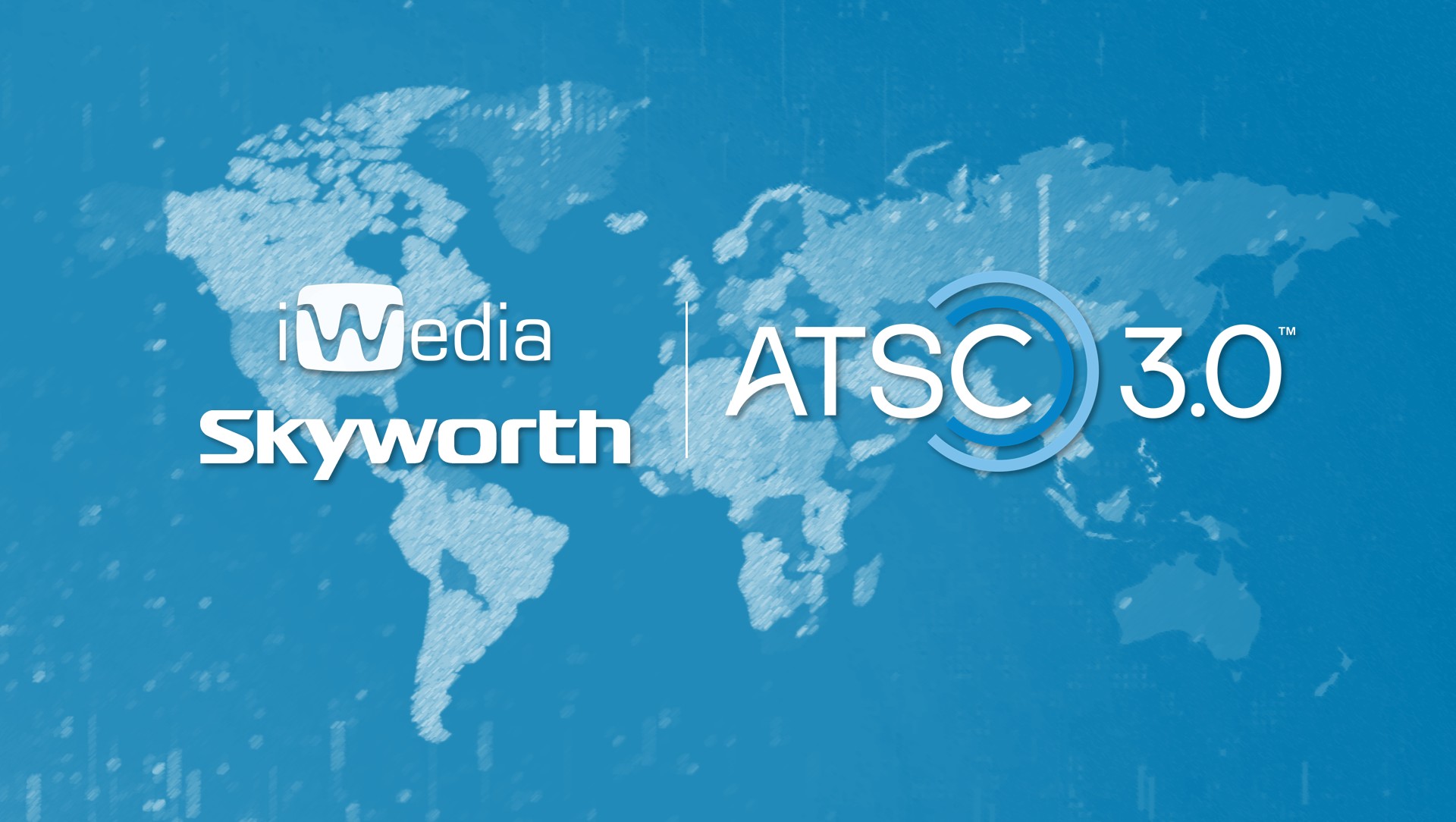MPEG HEVC compression not ready for primetime
At the 2013 NAB Show, the proliferation of next-generation MPEG compression technology, namely HEVC-compatible (aka, H.265) software and hardware encoders and decoders, gave the impression that the technology necessary to move and then display large data files containing the highest quality HD (1080p/60) and 4K (3840 x 2160 pixels for delivery or 4096 x 2160 pixels for production) content was ready to be deployed. This would clearly improve the value of bandwidth-constrained networks. However, a lack of an industry standard, the need for significantly more processing power to accurately compress such files and the ongoing move towards the current state-of-the-art (and standardized in January) AVC (H.264) technology to distribute full HD 1080p files would seem to make High Efficiency Video Coding (HEVC) a far off reality.
This is not to say that it won't happen, but don't hold your breath, as most people we spoke to at the show say it’s at least five years off. The benefits to multiplatform delivery associated with the new HEVC is said to be a 50-percent improvement in bit-rate efficiency when compared to the Advanced Video Coding (AVC) scheme, while maintaining the same image quality or better.
Like H.264 before it, HEVC is the latest version of the MPEG standard. It’s uses the same idea of recognizing the difference in motion between frames and finding near-identical areas within a single frame. With HEVC, these similarities are subtracted from subsequent frames, and whatever is left in each partial frame is mathematically transformed to reduce the amount of data needed to store each frame. This results in smaller files with nearly the same quality as the 4K original, for example, which makes them easier to distribute and saves operators in content storage costs.

At the NAB Show, companies such as Elemental Technologies, Ericsson, Fraunhofer Institute, Harmonic, Media Excel, Motorola, Rovi Corp. and Vanguard Video showed hardware and software solutions (in prototype form) and side-by-side demonstrations of H.265 and H.264 encoding to compare image quality results. In all cases the H.265 decode looked visibly better, even at bit rates as low as 5Mb/s (at the Fraunhofer exhibit booth). Each seemingly challenged the other to a compression/image quality contest comparison.
Elemental — which showed the ability to encode 1080p/60 content to HEVC in real time — went so far as to issue a highly public “HEVC Throwdown.” The contest dared competitors and customers to bring content on a USB drive and have it encoded in H.265 by Elemental and then see it simultaneously streamed live (at 500Kb/s) to a tablet device and at 1080p resolution to a high-definition television. Participants were encouraged to visit other video processing companies at NAB to request the same demonstration of capabilities. It wasn’t clear how many participated, but it was a small number.
“Those that only had DVD sources weren’t able to attempt the challenge because we didn’t have input for that, but those that had USB drives were able to load onto our server and see the transcode process at real-time (say 30fps), and now they have those transcoded files for evaluation in their labs,” said Keith Wymbs, vice president of marketing at Elemental.
The need for HEVC encoding is clear, but at what cost?
Because multichannel operators must process hundreds of files simultaneously to accommodate the different display devices, the need for real-time HEVC encoding (where the money in sponsorship is) is key. Most of the companies at the show demonstrated the ability to process on-demand files in real time, but live encoding in real time requires more processing and is harder to accomplish elegantly.
The professional video industry's #1 source for news, trends and product and tech information. Sign up below.
It was said that HEVC processing requires 10 times more processing than AVC on the encode side and two to three times more by comparison for the decode. That foreshadows the need for sophisticated parallel processing algorithm designs using multiple general-purpose programmable architectures (GPUs and CPUs) at the same time. Off-the-shelf workstations won't cut it.
“We are now successfully encoding HEVC in software in real time, but it’s not easy or cheap to do at this point,” said Dustin Encelewski, director of product marketing at Elemental Technologies, which has released a whitepaper on HEVC/H.265. “There’s also the issue of a lack of a standard, so vendors are doing its own software and hardware and experimenting to find the right solution that will work for customers. At the end of the day, the technology has to be configured in such a way that makes it practical and cost-effective to use. As an industry, we’re not there yet.”
Addressing legacy infrastructure
At the show, Ericsson unveiled its AVP 4000 encoder platform for the delivery of TV services over all networks. The unit is using Ericsson’s in-house developed programmable video processing chip, which it said addresses multiple applications, regardless of codec, resolution or network. (Ericsson launched what it called the world’s first HEVC/H.265 encoder at IBC last fall, the 5500 HEVC.)

“By addressing all applications, codecs, resolutions and profiles, the AVP 4000 single platform addresses legacy equipment while also making it easy to integrate, expand, re-purpose, repair and upgrade,” said Matthew Goldman, senior vice president of technology in Ericsson’s Solution Area TV group.
He added that customers can use the AVP 4000 for H.264 and JPEG2000 encoding today and then migrate to HEVC via a simple software upgrade.
“This lowers the overall cost of ownership and makes deployments easier to invest in," he said.
Goldman said many of the same issues that affected the AVC standard in its early deployments would delay full-scale HEVC deployments. HEVC will initially find a home for B2B backhaul and contribution applications.
“At this point, the tricky part is real-time encoding of HEVC, and we believe it can't be done well in software alone,” Goldman said. “We want to be in control of our own destiny. That’s why Ericsson, for the first time ever, has developed its own compression chip. It’s a purpose-built, easily programmable design that includes all our own algorithms that have been developed over years of lab and real-world testing. The Main 10 profile is key to this.”
Telcos Verizon in the U.S. and TELUS in Canada are now experimenting with the new AVP 4000 to support future TV platforms with high-quality picture and services. Therein lies the attraction for operators and other types of content distributors. Better image quality (Ericsson said its 4X better) often results in more discerning viewers.
Advanced data rate reduction
Harmonic showed a demo in its both of its ProMedia Live real-time and ProMedia Xpress file-based transcoders using HEVC to compress UltraHD (4K and higher) content supporting a variety of real-world scenarios. The point was to show that UltraHD could be employed at bandwidths currently used for HD, using HEVC technology instead of AVC. UltraHD content was compressed with HEVC at 3Mb/s to 7Mb/s using a Broadcom Ultra HD HEVC chipset decoder. Alongside this, a software decoder from NTT Docomo was shown to demonstrate Ultra HD HEVC decoding for the multiscreen delivery market.
“The demo outlined the benefits of Harmonic’s superior preprocessing when upconverting HD content for display on an Ultra HD screen,” said Ian Trow, senior director of emerging technology and strategy at Harmonic. “The benefits of the (Harmonic) ProMedia adaptive bit-rate multiscreen platform used for HD compression yields significant quality gains when compared to legacy HD content similarly upconverted to Ultra HD.”
Fraunhofer HHI showed a new real-time video compression H.265/ MPEG-HEVC engine, in software, that it said it developed with leading players in mobile technology and consumer electronics. At NAB, the research institute’s exhibit booth included a demonstration of HEVC decoding of 4K content at 5 Mb/s (the lowest with good quality that I saw on the show floor).
“At Fraunhofer, we are dedicated to develop technologies and standards that not only solve the issues faced by the industry today, but anticipate the needs of the future,” said Dr. Thomas Schierl, head of group multimedia communications at Fraunhofer HHI. “Our role in the development of HEVC and the real-time software decoder showcases our ability to develop innovations that are ahead of the market to enhance the digital media workflow of today and tomorrow.”
Fraunhofer HHI’s HEVC real-time software decoder uses an advanced multi-threaded architecture, which the company says makes it very efficient at low bit rates (with low latency).
As part of its HEVC real-time decoder demo, Fraunhofer HHI, part of the Fraunhofer Digital Cinema Alliance, also hosted a series of test suites for HEVC-compliant decoder chips and set-top boxes.
Targeting multiplatform delivery
The Motorola Mobility division of Motorola also showed HEVC encoding and decoding — using a Vanguard software encoder/decoder at its 2013 NAB Show booth. The company's stated goal was to highlight how the compression efficiency of HEVC facilitates the delivery of high-quality video over bandwidth-constrained networks to multiple platforms. One demo focused on a real-time HEVC encoder delivering streaming content to a Google Nexus 10 tablet for real-time decoding and playback. A second demo showcased real-time HEVC HTTP live streaming to an Apple iPad. A third featured an IP set-top box decoding HEVC.

While the talk of this year’s NAB Show was 4K delivery, the technology is not yet ready for real-world deployments. There’s too much legacy equipment that continues to offer operators “good enough” quality using AVC and even previous generation MPEG-2 technology. That’s right: MPEG-2 still works well for most types of HD content delivery — to TVs, the Internet and mobile devices alike.
There was talk that several content distributors will experiment with HEVC compression at the upcoming World Cup soccer tournament in Brazil next summer. As TV screens get larger, the need for better compression is clear. But at what cost?
Then, of course, the industry has to settle on a standard way of H.265 coding, which apparently is part of the ATSC 3.0 specification now being developed and planned for initial deployments in 2016. [There’s patent negotiations occurring right now. The Joint Collaborative Team on Video Coding of the ITU-T Visual Coding Experts Group and the ISO/IEC Moving Pictures Experts Group (MPEG) are working on it. There is now a Recommendation ITU-T H.265 being considered for ratification.] Once a standard is established, vendors will then build products to support it. Satellite- and fiber-based contribution should benefit the most in the short term.
The consensus is that there’s still a lot of improvement being made to the MPEG compression platform, so the delivery of HD, 4K and even higher image quality content is possible to support widespread consumer consumption. It’s just a matter of how long it will take.
